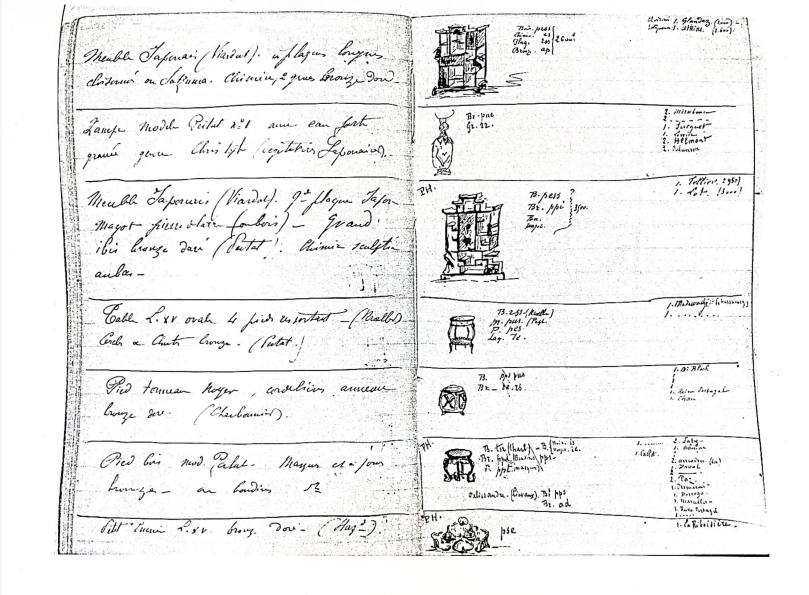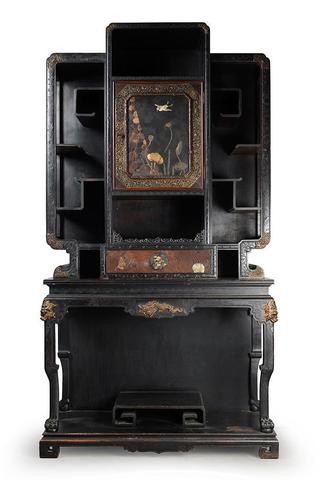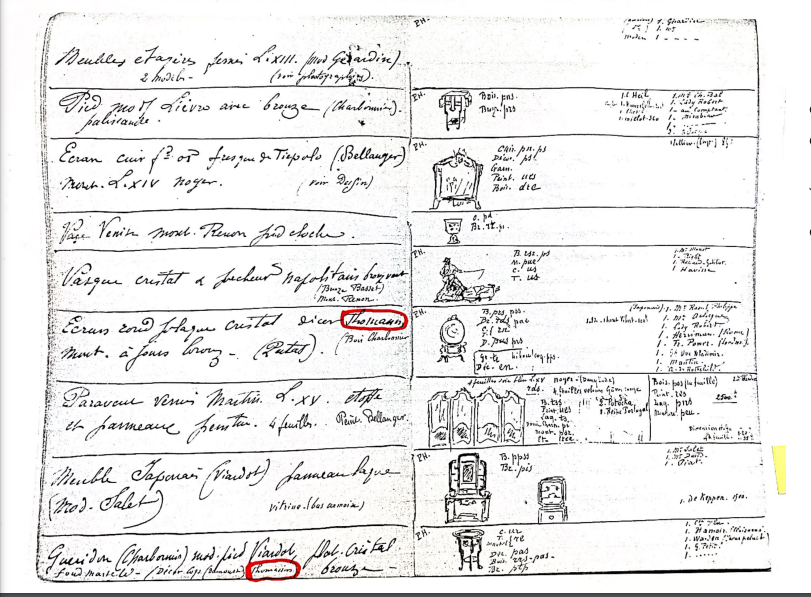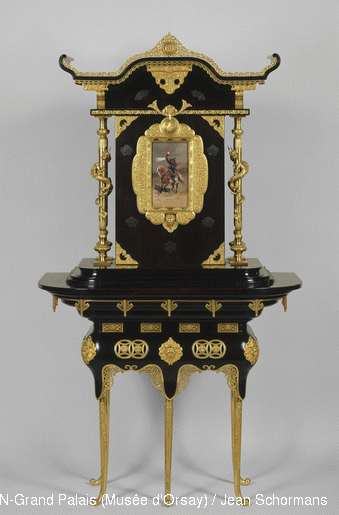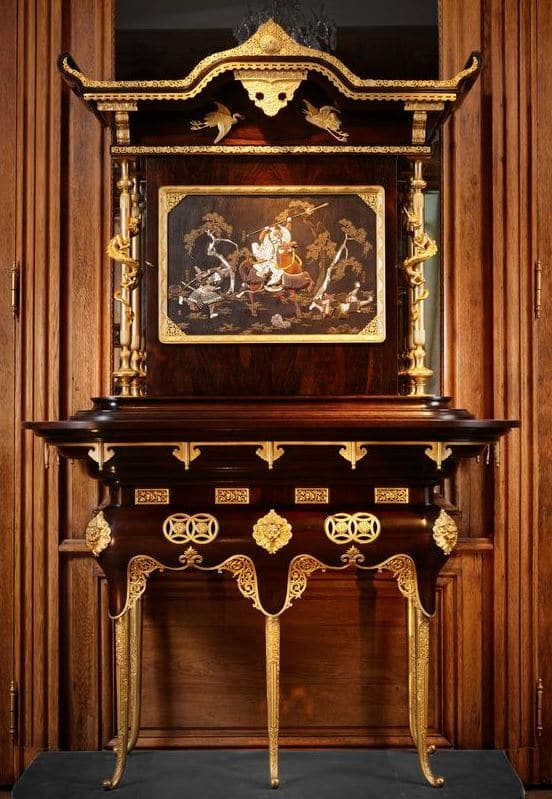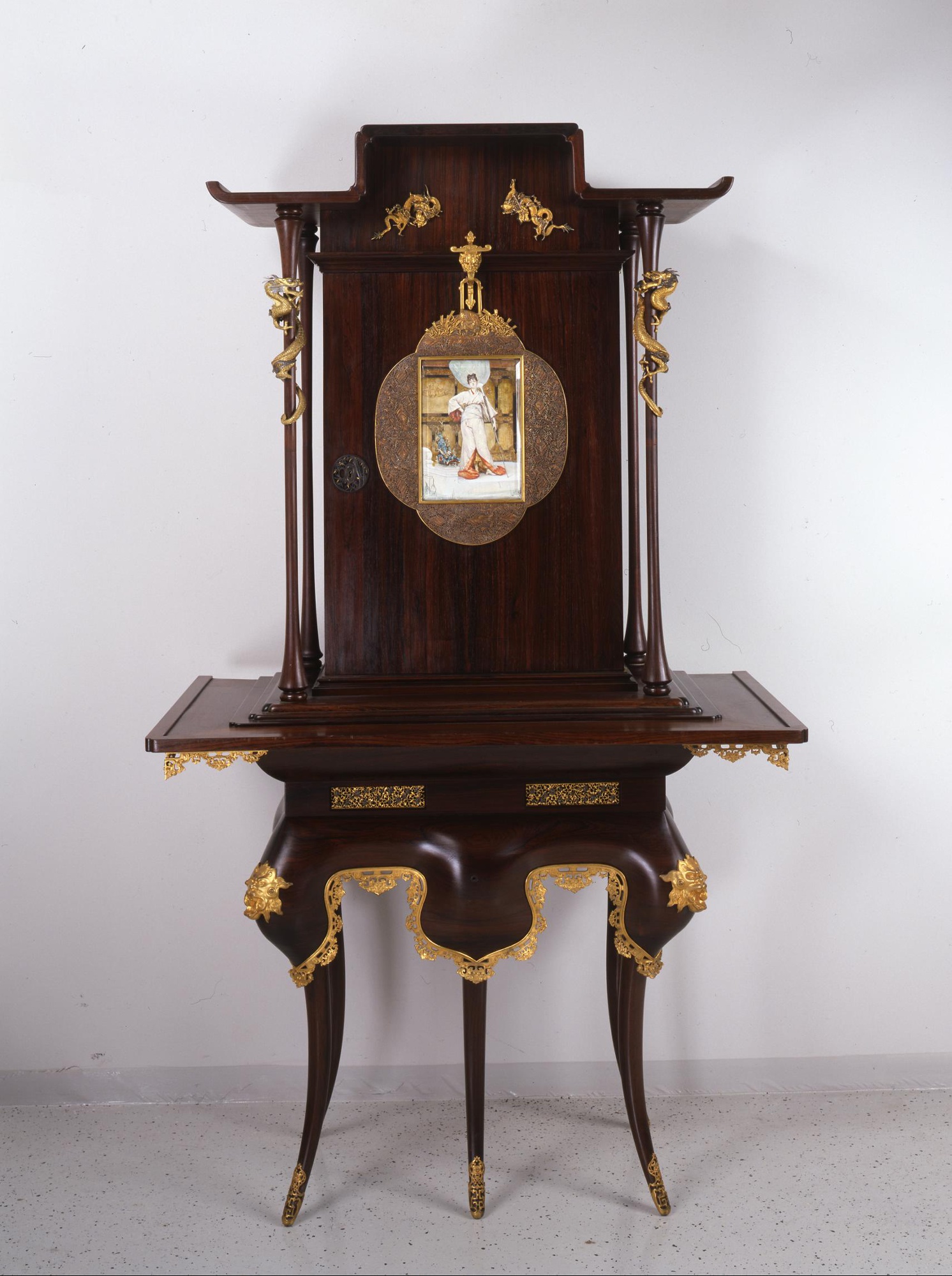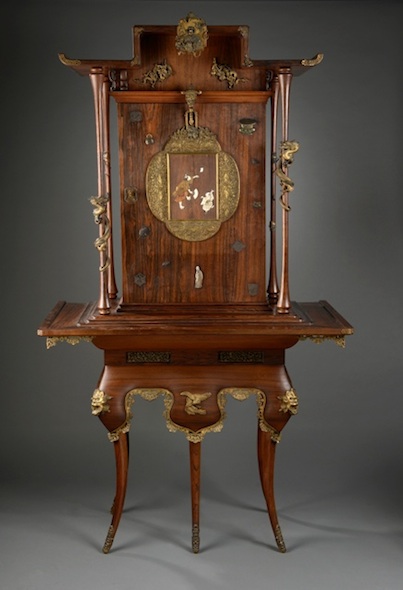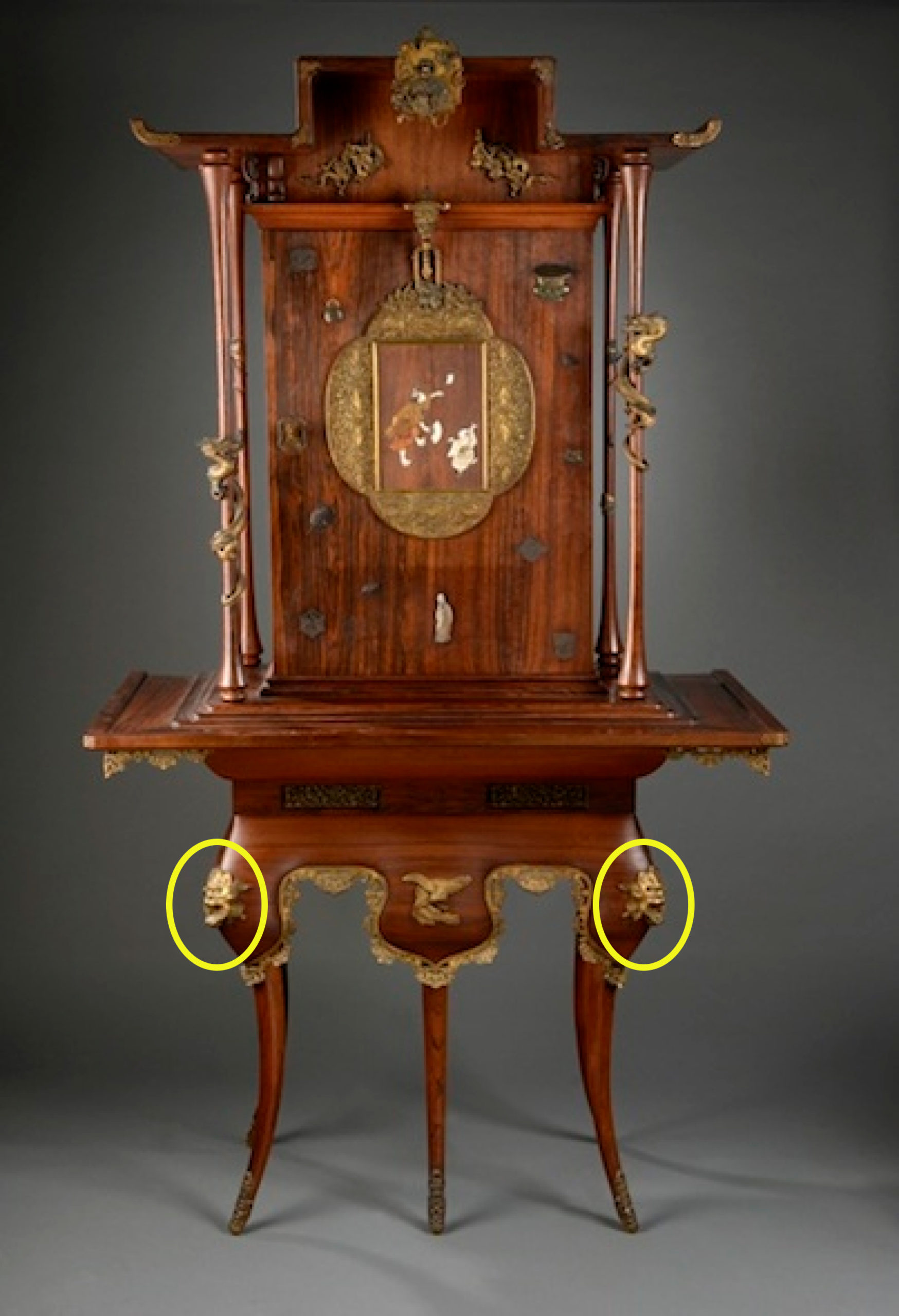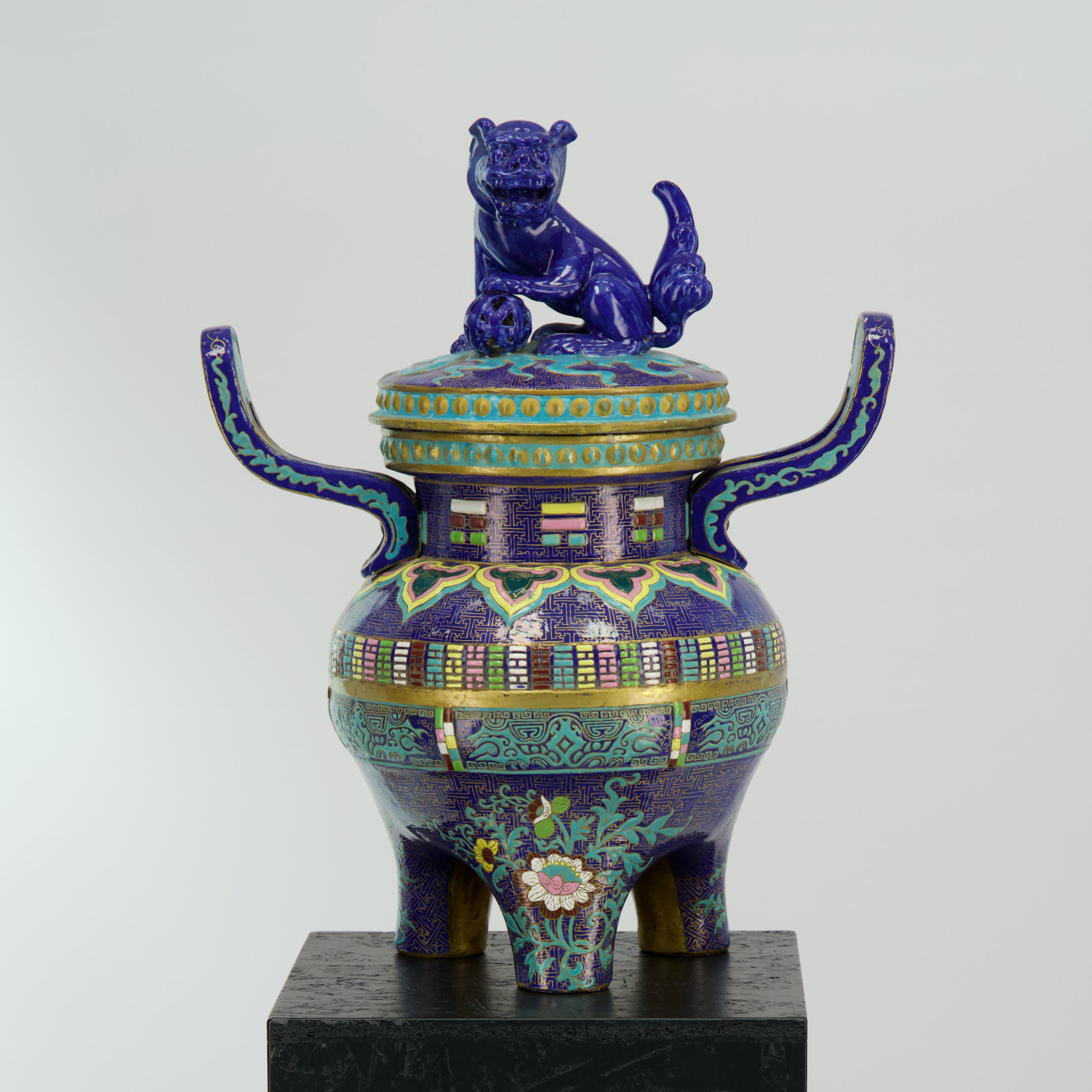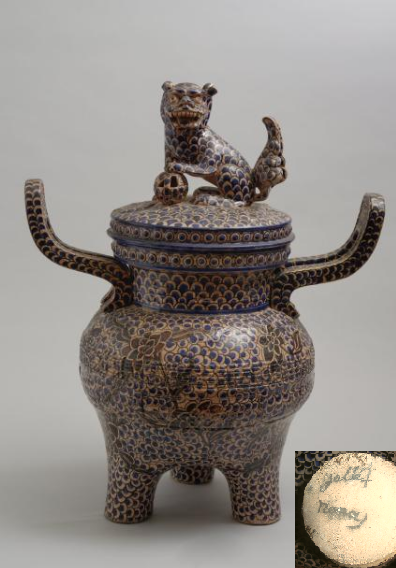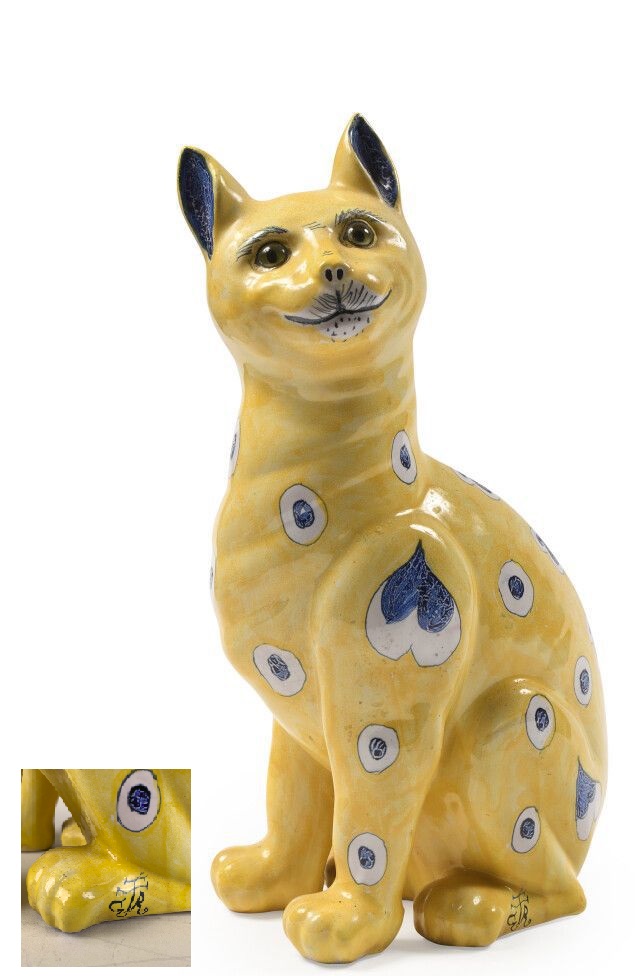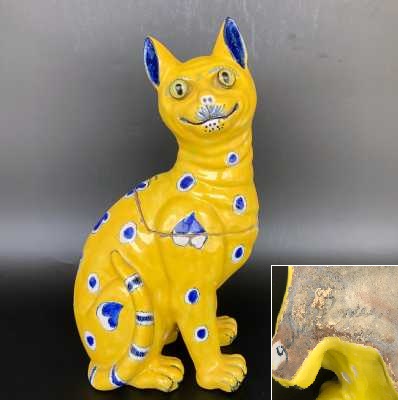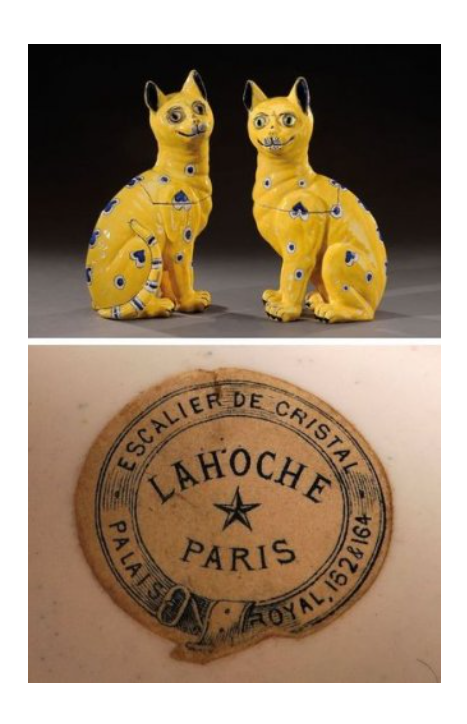Henry Pannier’s notebooks, precious asset kept until now by the family, have permit progresses on the knowledge of the house, still not that much studied. The informations that are written in them such as the buyers’ names, the prices or even the artists’ names but especially the draws allow to understand in a new way the extensive and value of the production. They also are the occasion to discover works of art that were until now anonymous or badly attributed because of the absence of signature, stamp or label, but very much recognizable thanks to the precision of these draws.
Latest discoveries
Christie’s Sale of the 12th November, 2020
lot designated as : “A French Japonisme ormulu and chinese cloisonne enamel-mounted mahogany etagere-cabinet in the manner of Gabriel Viardot.Paris, late 19th century”
Coutau-Bégarie’s sale of the 28th November, 2014
lot desiganted as :
“Cabinet en bois noirci, reposant sur un piètement à jarrets de lion stylisé, tablette à enroulement reposant sur la base, la partie supérieure, ouvrant à un tiroir et une porte ornée d’un panneau de laque du japon, au centre d’étagères. Vers 1900-1910 Etiquette au dos « Maison des Bambous. 170 Boulevard Haussmann »”
It appears the label was stuck by mistake
Cabinets inspired by E. Lièvre’s ones
The japanese influence of the designer and furniture maker Edouard Lièvre (1828-1886)had a huge importance on the Pannier brothers’ furniture production.
Moreover the artist’s drawings and the models were auctioned in 1890 following his death and the Pannier brothers bought some lots.
It’s especially the cabinet in the Japanese taste, made around 1878 and produced in several versions that was the origin of a cabinets series made by the Pannier brothers.
Four exemplars produced by E. Lièvre are today known. Two are conserved in the musée d’Orsay, another in the BNF, and another in the galerie Steinitz.
Edouard Lièvre, Japanese displaycabinet, circa 1878
Conserved in the cabinet des médailles et antiques of the BNF
H : 198 cm, W : 134cm, D : 61cm
Edouard Lièvre, Cabinet on gilt bronze base, circa 1880
Central panel depicting « Baccara » painted from Jehan Georges Vibert
Conserved in the musée d’Orsay
H : 211 cm, W : 111 cm, D : 57 cm
Edouard Lièvre, Cabinet on gilt bronze base, circa 1877
Oil painting on the central panel by Edouard Detaille figuring a japanese warrior on a horse
Conserved in the musée d’Orsay
H : 211 cm ; W : 111 cm ; D. 57 cm
Regarding the series produced by l’Escalier de Cristal, Henry Pannier’s notebooks tell us that six versions were made and sold. For now only four have been found. One of them is conserved in the Hermitage Museum in Saint Petersburg and comes from the Grand Duc Wladimir’s collection. The three others were auctioned (cf. Bonhams, Daguerre et Lempertz).
Their study shows that they are slightly different thant the originals by E.Lièvre. Indeed, the drawing is more purifyed and have less bronze. The pediment lines were modernized and the bronze monster masks adorn the corners of the foot. Furthermore, the bronze used for the feet has been replaced by wood. Each of them is different from the other, especially the central panel, allowing the furniture to be adapted according to each taste and means.
L’Escalier de Cristal, Cabinet adorned with George Clairin’s watercolor, circa 1897
H : 205 cm, W: 115 cm, D : 66 cm
Conserved in the Hermitage Museum in Saint Petersburg.
Ordered by the grand duc Vladimir of Russia and placed in the Anitchkov palace in 1897, living place of the Impress Maria Fedorovna (1847 – 1928)
L’Escalier de Cristal, Cabinet adorned with a lacquer panel from the Meiji period depicting Juroujin, Longevity God, circa 1895
H : 204 cm, W : 116,5 cm, D : 67 cm
Bonhams Sale of the 4 of December 2008
L’Escalier de Cristal, Cabinet adorned with a lacquer panel depicting a Nô theater scene, circa 1895
H : 208 cm, W : 118 cm, D : 66 cm
Daguerre’s Sale of the 25 of November 2013
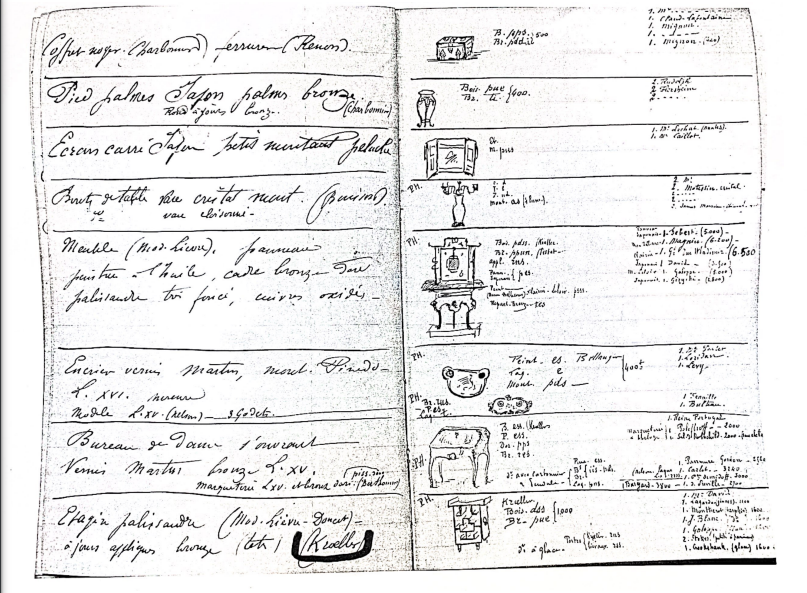
Bronzes’ expertise
It’s thanks to a comparative study of the decorative bronzes that the attribution of this table has been made.
Indeed, we find the same bronzes depicting a chimera mascaron on other furniture of which the attribution to l’Escalier de Cristal is sure.
Especially on the corners of one of the cabinet from the series inspired by Edouard Lièvre’s model.
And also on the furniture sold in auction by Coutau – Bégarie in 2014 as a realization by the Maison des Bambous. It is also important to notice the bronze decoration on the center depicting a dragon of which the same model is also on the Japanese table also adorned with monster masks.
This table doesn’t have stamp or label, nevertheless we have to notice the quality of execution. The choix of materials and the sculpture precision are typical of Viardot’s work who multiplicates the decoration but is never too much.
Indeed, the realization quality, the elegant decor and the use of the same bronze decorations lead us to think that this table was made by the famous furniture maker for the Pannier brothers. Moreover, Viardot had a contract with the store making him supplier for exclusive models.
The collaboration between Charles Gallé and Emile Pannier
This ceramic covered pot with chinese decoration takes the shaped of a traditional chinese perfume burner without having the real function as it is holeless.
It was made by Charles Gallé (1818 – 1902) maybe in collaboration with his son Émile Gallé (1846 – 1904) for l’Escalier de Cristal in the second half of the 19th century and more precisely between 1872 and 1884, as shows the label below. We can read on it the names of Pannier and Lahoche, directors of the house between 1852 and 1872, and the address. From 1872, the store is moved on the 6 rue Scribe and 1 rue Auber by Émile Pannier who continues the business alone but for commercial reasons keeps the label with the two names.
We can suppose that this model imitating a perfume burner was made by Charles Gallé, very likely following an order of Emile Pannier, as we don’t recognize the stylistic shape of the artist. Nevertheless, two other models, identicals in their shape but with different decoration are known and signed. One of them was auctioned in 2013, it is signed « Gallé Nancy », signature of Charles, the other is illustrated on the Émile Gallé’s archives in the musée d’Orsay and shows the signatures of Émile « E. Gallé déposé » and Charles « Gallé Nancy » .
From 1885, Émile Gallé was part of the many artists who collaborate with l’Escalier de Cristal. He made models of crystal or glass decorative art, which he signed. We can then think that before his son, Charles Gallé already made some models for the different directors of l’Escalier de Cristal without putting his signature.
Other elements permit to push this theory. Indeed, we find on the market some very characteristic ceramic pieces depicting a sat cat with a yellow body punctuates with bleu hearts. Some of them also has the heads removable. They bear Charles Gallé’s signature : « Gallé Nancy » or event « G.R » for Gallé – Reinemer.
This name correponds to the crystal and earthenware store that his wife’s family owned. Indeed, he married Fanny Reinemer in 1845 and sold his production in the store. After winning a mention honorable in the International Exhibition of 1855, the store then named « Veuve Reinemer et Gallé » changed its name for « Gallé – Reinemer » and will become next simply « Gallé ».
In 2011, a pair of similar pieces was auctioned at Aguttes. Nevertheless, it was not the ceramicist signature we could on read below but a label l’Escalier de Cristal under the direction of Lahoche (1840-1852). The ressemblance between the models allow us to legitimately think they were made by the same artist Charles Gallé.
This is then a new evidence of the collaboration between Charles Gallé and l’Escalier de Cristal, far before the two sons’ one.

